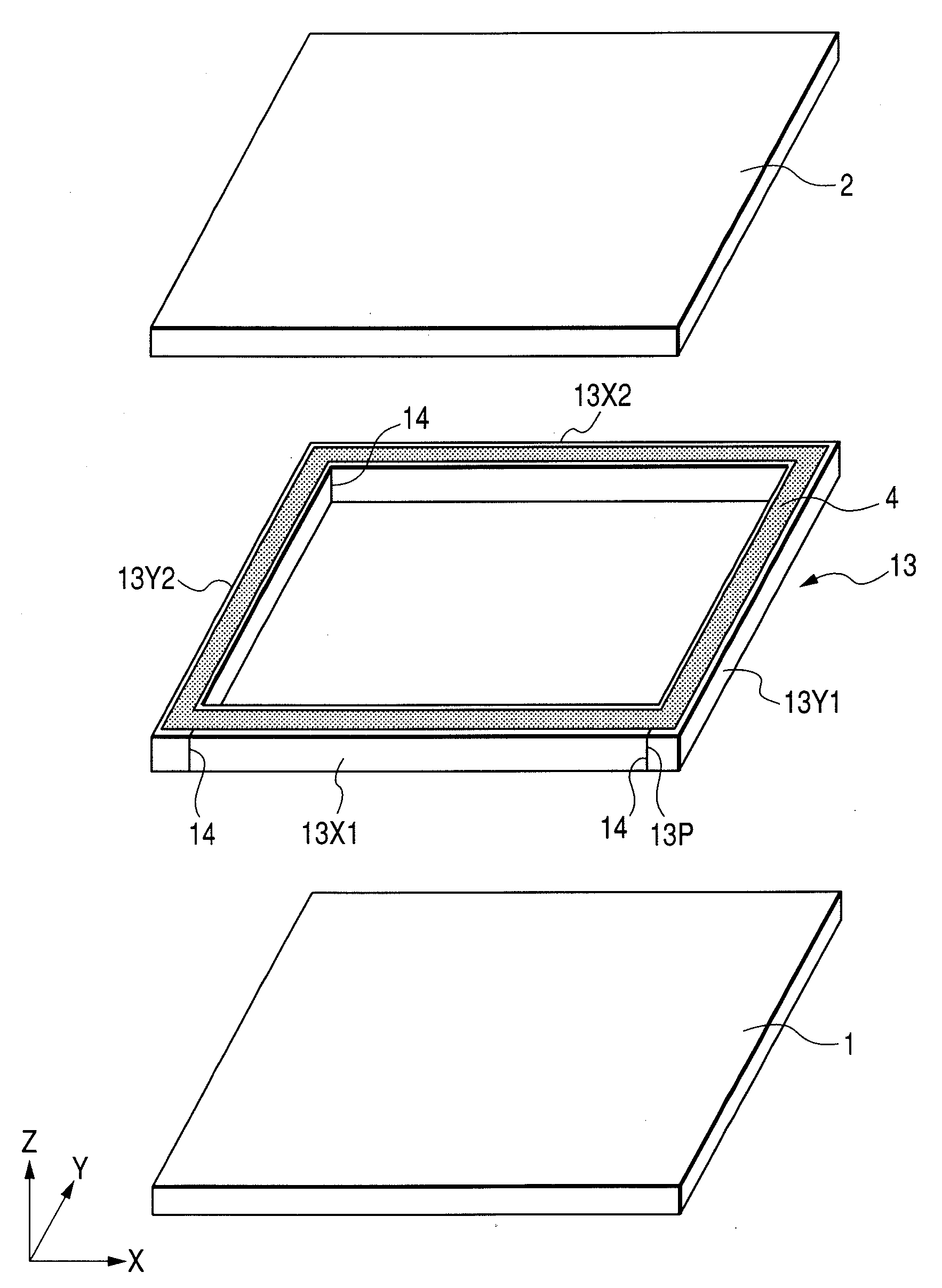Display device
a technology of a display device and a display body, which is applied in the direction of discharge tubes, luminescnet screens, instruments, etc., can solve the problems of poor air tightness, high cost, and difficulty in handling the support body without damage, so as to suppress the occurrence of leakage and improve quality and reliability
- Summary
- Abstract
- Description
- Claims
- Application Information
AI Technical Summary
Benefits of technology
Problems solved by technology
Method used
Image
Examples
first embodiment
[0069]FIG. 1 is a developed perspective view of a display device according to a first embodiment of the present invention. Also, FIG. 1 schematically explains how a rear substrate, a front substrate and a support body are assembled. In the figure, the Z axis indicates the direction in which the front substrate 2 and the rear substrate 1 are stacked. FIG. 2 is an enlarged cross-sectional view of the support body shown in FIG. 1. FIG. 3 shows a junction between constituent pieces of the support body. FIG. 3A is an enlarged cross-sectional view taken along line A-A′ of FIG. 2. Likewise, FIG. 3B is an enlarged sectional view taken along line B-B′ of FIG. 2.
[0070]In this display device, the rear substrate 1 and the front substrate 2 are formed of a glass plate and the support body 13 is made of a glass material. Here, various components such as electron sources, phosphor layers and the like which are formed on respective inner surfaces of the rear substrate 1 and the front substrate 2 ar...
second embodiment
[0087]FIG. 7 is an enlarged sectional view for explaining a display device according to a second embodiment of the present invention. FIG. 7 shows a junction taken along line A-A′ indicated in FIG. 2. Each part is given the same reference numeral as the corresponding one in the aforementioned figures and its description is omitted here if the part is identical to the corresponding one. FIG. 7 is different from FIG. 3A in that, for the bonding members 14, the first bonding member 141 is applied to a central transverse area of each bonding surface 13P in the longitudinal direction of each bonding surface 13P while the second bonding member 142 whose softening temperature is lower than that of the first bonding member 141 is applied to the remaining upper and lower areas of the first bonding member 141. The support body members 13X1, 13X2, 13Y1 and 13Y2, not shown in the figure, are hermetically bonded together via their respective bonding surfaces 13P.
[0088]Also in this construction, ...
third embodiment
[0090]FIG. 8 is an enlarged top sectional view of a support frame for explaining a display device according to a third embodiment of the present invention. Each part is given the same reference numeral as the corresponding one in the aforementioned figures and its description is omitted here if the part is identical to the corresponding one. FIG. 8 is different from FIG. 2 in that two long-side support body members 13X1, 13X2 and two short-side support body members 13Y1, 13Y2, which are combined to form a support body 13 have different widths.
[0091]That is, width WX of the two long-side support body members 13X1 and 13X2 is larger than width WY of the two short-side support body members 13Y1 and 13Y2 (WX>WY). The two long-side support body members 13X1 and 13X2 are sandwiched between the two short-side support body members 13Y1 and 13Y2 via bonding members 14 which are structured as described above with FIG. 3A or FIG. 7.
[0092]In this construction, the two long-side support body mem...
PUM
 Login to View More
Login to View More Abstract
Description
Claims
Application Information
 Login to View More
Login to View More - R&D
- Intellectual Property
- Life Sciences
- Materials
- Tech Scout
- Unparalleled Data Quality
- Higher Quality Content
- 60% Fewer Hallucinations
Browse by: Latest US Patents, China's latest patents, Technical Efficacy Thesaurus, Application Domain, Technology Topic, Popular Technical Reports.
© 2025 PatSnap. All rights reserved.Legal|Privacy policy|Modern Slavery Act Transparency Statement|Sitemap|About US| Contact US: help@patsnap.com



